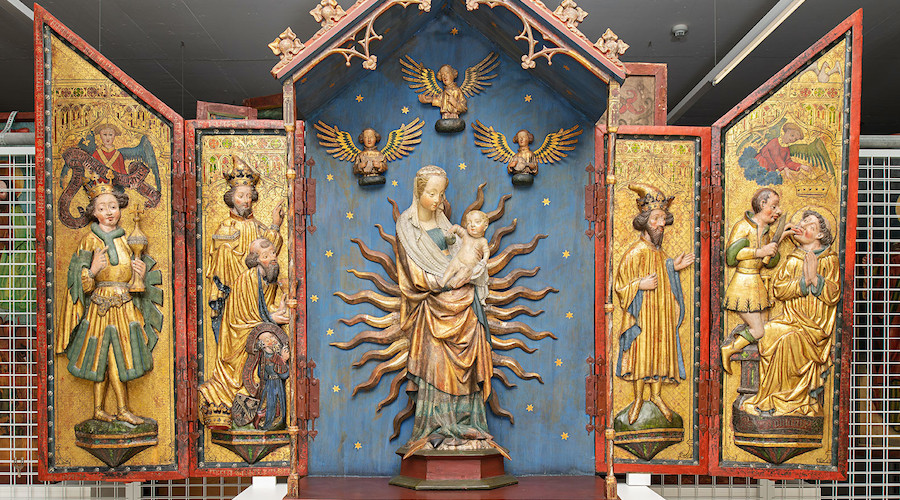Ever heard of medieval zwischgold?

Scientists at the Paul Scherrer Institute (PSI) have managed to produce nanoscale 3D images of zwischgold, a material consisting of ultra-thin gold foil supported by a silver base layer, which was used for gilding sculptures in the late Middle Ages.
In a paper published in the journal Nanoscale, the researchers say their examination of this highly sophisticated medieval production technique explains why restoring such precious gilded artifacts is so difficult.
To conduct their study, the scientists used sophisticated microscopy techniques to analyze minute samples of materials taken from an altar and wooden statues originating from the fifteenth century. The altar, which displays Mary cradling baby Jesus, is thought to have been made around 1420 in Southern Germany and stood for a long time in a mountain chapel on Alp Leiggern in the Swiss canton of Valais.
The material sample was taken from a fold in the Virgin Mary’s robe. Tiny samples from the other two medieval structures were supplied by Basel Historical Museum.
Not gold leaf
Zwischgold was used to gild sacred figures. It is not actually gold leaf, which was quite expensive, but a special double-sided foil of gold and silver where the gold can be ultra-thin because it is supported by the silver base.
“Although zwischgold was frequently used in the Middle Ages, very little was known about this material up to now,” PSI physicist Benjamin Watts said in a media statement. “So we wanted to investigate the samples using 3D technology which can visualize extremely fine details.”
Other microscopy techniques had been used previously to examine zwischgold, however, they only provided a 2D cross-section of the material. In other words, it was only possible to view the surface of the cut segment, rather than looking inside the material. The scientists were also worried that cutting through it may have changed the structure of the sample.
But an advanced microscopy imaging method used today, ptychographic tomography, provided a 3D image of zwischgold’s exact composition for the first time.
“Ptychography is a fairly sophisticated method, as there is no objective lens that forms an image directly on the detector,” Watts explained. Ptychography actually produces a diffraction pattern of the illuminated area, in other words, an image with points of differing intensity.
By manipulating the sample in a precisely defined manner, it is possible to generate hundreds of overlapping diffraction patterns. “We can then combine these diffraction patterns like a sort of giant Sudoku puzzle and work out what the original image looked like,” he said. A set of ptychographic images taken from different directions can be combined to create a 3D tomogram.
The advantage of this method is its extremely high resolution. “We knew the thickness of the zwischgold sample taken from Mary was of the order of hundreds of nanometers,” Watts said. “So we had to be able to reveal even tinier details.”
The 3D images show how thinly and evenly the gold layer is over the silver base layer.
“Many people had assumed that technology in the Middle Ages was not particularly advanced,” Qing Wu, lead author of the paper, said. “On the contrary: this was not the Dark Ages, but a period when metallurgy and gilding techniques were incredibly well developed.”
Secret recipe revealed
Wu noted that, unfortunately, there are no records of how zwischgold was produced at the time.
But based on nanoscale images and documents from later epochs, the art historian now knows the method used in the 15th century: first, the gold and the silver were hammered separately to produce thin foils, whereby the gold film had to be much thinner than the silver.
Then the two metal foils were worked on together.
“This required special beating tools and pouches with various inserts made of different materials into which the foils were inserted,” she explained. This was a fairly complicated procedure that required highly skilled specialists.
“Our investigations of zwischgold samples showed the average thickness of the gold layer to be around 30 nanometers, while gold leaf produced in the same period and region was approximately 140 nanometers thick,” Wu said. “This method saved on gold, which was much more expensive.”
At the same time, there was also a very strict hierarchy of materials: gold leaf was used to make the halo of one figure, for example, while zwischgold was used for the robe.
Because this material has less of a sheen, the artists often used it to colour the hair or beards of their statues.
“It is incredible how someone with only hand tools was able to craft such nanoscale material,” Watts noted. Medieval artisans also benefited from a unique property of gold and silver crystals when pressed together: their morphology is preserved across the entire metal film.
“A lucky coincidence of nature that ensures this technique works,” the physicist said.
More News
Kinross buys 9.9% stake in Nevada-focused Eminent Gold
Eminent Gold currently has three gold exploration projects in Nevada.
April 07, 2025 | 03:21 pm
PDAC JV video: New Zealand aims to fast-track mining
New processes are to help the island nation develop its gold, coal and rare earth minerals while respecting Indigenous rights, says resources minister.
April 07, 2025 | 02:55 pm
US discusses tariffs, critical minerals with Pakistan
The Trump administration has also used prospects of engagement over critical minerals with others countries.
April 07, 2025 | 01:13 pm
{{ commodity.name }}
{{ post.title }}
{{ post.excerpt }}
{{ post.date }}




Comments